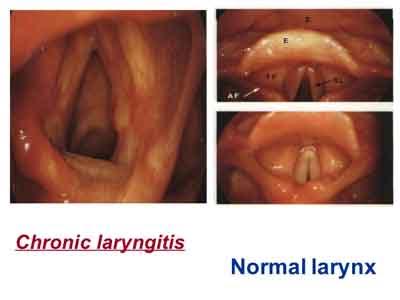- Home
- Editorial
- News
- Practice Guidelines
- Anesthesiology Guidelines
- Cancer Guidelines
- Cardiac Sciences Guidelines
- Critical Care Guidelines
- Dentistry Guidelines
- Dermatology Guidelines
- Diabetes and Endo Guidelines
- Diagnostics Guidelines
- ENT Guidelines
- Featured Practice Guidelines
- Gastroenterology Guidelines
- Geriatrics Guidelines
- Medicine Guidelines
- Nephrology Guidelines
- Neurosciences Guidelines
- Obs and Gynae Guidelines
- Ophthalmology Guidelines
- Orthopaedics Guidelines
- Paediatrics Guidelines
- Psychiatry Guidelines
- Pulmonology Guidelines
- Radiology Guidelines
- Surgery Guidelines
- Urology Guidelines
Chronic Laryngitis - GOI Standard Treatment Guidelines

Following are the major recommendations:
Chronic Laryngitis Without Hyperplasia
It is a diffuse inflammatory condition symmetrically involving the whole larynx, i.e. true cords, ventricular bands, and root of the epiglottis.
Aetiology
- It may follow incompletely resolved acute simple laryngitis or its recurrent attacks.
- Presence of chronic infection in paranasal sinuses, teeth and tonsils.
- Occupational factors, e.g. exposure to dust and fumes such as in miners, strokers, gold or iron smiths and workers in chemical industries.
- Smoking and alcohol.
- The persistent trauma of a cough as in chronic lung disease.
- Vocal abuse.
Clinical Features
- Hoarseness. This is the commonest complaint
- Constant hawking. There is dryness and intermittent tickling in the throat and patient is complited to clear the throat repeatedly.
- Discomfort in the throat.
- Cough. It is dry and irritating.
Treatment
- Eliminate infection of upper or lower respiratory tract. Infection in the sinuses, tonsils, teeth or chronic chest infection should be treated.
- Avoidance of irritating factors, e.g. smoking, alcohol or polluted environment.
- Voice rest and speech therapy. Voice rest has to be prolonged for weeks or months.
- Steam inhalations. They help to loosen secretions and give relief.
- Expectorants. They help to loosen viscid secretions and give relief from hawking.
Chronic Hypertrophic laryngitis
It may be either a diffuse and symmetrical process or a localised one, the latter appearing like a tumour of the larynx.
Aetiology
Same as discussed under chronic laryngitis without Hyperplasia.
Pathology
Pathological changes start in the glottis region and later may extend to ventricular bands base of the epiglottis and even subglottis. Initially, there is hyperaemia, oedema and cellular infiltration in the submucosa. The mucous glands suffer hypertrophy at first but later undergo atrophy with diminished secretion and dryness of larynx.
Clinical features
This disease mostly affects males (8:1) in the age group of 30-50 years.
Hoarseness, constant desire to clear the throat, dry cough and discomfort in the throat when the voice has been used for an extended period of time, are the common presenting symptoms.
Examination:
On examination, changes are often diffuse and symmetrical.
- Laryngeal mucosa, in general, is dusky red and thickened.
- Vocal cords appear red and swollen.
- Ventricular bands appear red and swollen and may be mistaken for prolapsed or eversion of the ventricle.
- Mobility of cords gets impaired due to oedema and infiltration, and later due to muscular atrophy or arthritis of the cricoarytenoid joint.
Treatment
Conservative: Same as for chronic laryngitis without hyperplasia. Surgical: Stripping of vocal cords, removing the hyperplastic and oedematous mucosa, may be done in selected cases. Damage to underlying vocal ligament should be carefully avoided. One cord is operated at a time.
For further reference log on to :
http://clinicalestablishments.gov.in/WriteReadData/4251.pdf

Disclaimer: This site is primarily intended for healthcare professionals. Any content/information on this website does not replace the advice of medical and/or health professionals and should not be construed as medical/diagnostic advice/endorsement or prescription. Use of this site is subject to our terms of use, privacy policy, advertisement policy. © 2020 Minerva Medical Treatment Pvt Ltd